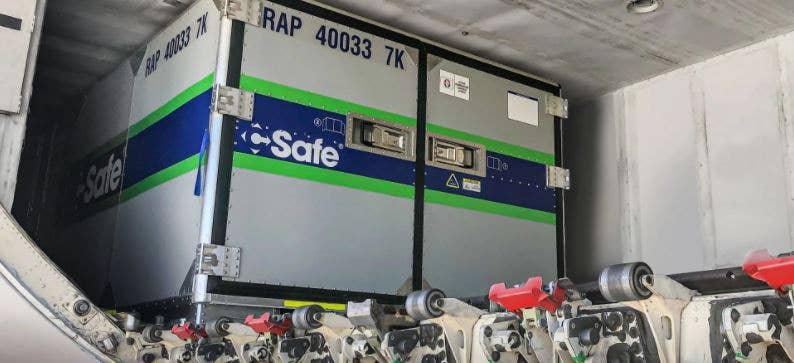
An active refrigerated container in the lower hold of a passenger aircraft. [Photo: Csafe]
Editor’s Note: This article originally appeared on FreightWaves.com
The FAA is asking airlines for data on their experience shipping COVID-19 vaccines to understand lessons learned that could be disseminated as best practices or inform development of regulations, minimum standards or guidance, for the safe and efficient transport of these medical supplies.
The interest stems in part from the need for some vaccines to be transported with larger amounts of dry ice than is normally carried on board aircraft.
According to the notice in the Federal Register on Tuesday, the FAA wants to know:
- Has the volume of vaccines transported per pound of dry ice increased over the duration of the COVID-19 pandemic?
- Were there observed lower sublimation rates—the speed at which carbon dioxide breaks down from a solid to a gas—owing to improved packaging technology or other factors, and to what factors can these lower sublimation rates be attributed?
- What risk mitigations have been utilized to enable safe and efficient air operations with larger-than-normal quantities of dry ice?
- Was there anything that limited the ability to transport COVID-19 vaccines efficiently while maintaining aviation safety?
- What are key takeaways or accomplishments from the COVID-19 vaccine transportation effort over the past year that show the value of working closely with shippers, airframe manufacturers and the FAA for data-driven safe and efficient operations?
Why This Matters
Both passenger and all-cargo airlines have been critical to the effort of governments and humanitarian groups to distribute coronavirus vaccines around the world. They have moved billions of doses from pharmaceutical makers within countries and across borders to areas of need.
DHL Express, for example, recently said it has delivered more than 2 billion COVID vaccine doses to more than 175 countries.
Many COVID vaccine shipments kept at ultra-cold temperatures required more dry ice to maintain safety and efficacy. That is especially true for the product developed by Pfizer (NYSE: PFE) and German partner BioNTech, which required vaccines be kept at minus 94 degrees Fahrenheit (minus 70 Celsius).
Vaccines moving by air are typically packed in large insulated containers with compartments for dry ice, although some types of equipment use battery-powered refrigeration systems instead. Major cooler manufacturers include Csafe, Envirotainer, Opticooler and SkyCell.
Initial concerns about spoilage because of insufficient refrigerated facilities and equipment at airports and logistics centers turned out to be a Y2K event that never materialized, because of extensive planning by the air logistics sector and less stringent needs for subzero storage than originally expected.
A team of FAA specialists has closely worked with air carriers, logistics companies, and other aviation stakeholders to address unique safety matters associated with the vaccines, such as changing packaging configurations, use of data loggers that monitor temperature, and increased dry ice limits. A government-industry working group meets periodically to share ideas, successes and challenges related to transporting COVID-19 vaccines.
In late 2020, the FAA gave passenger airlines permission to carry more dry ice than normally permitted when operating in cargo-only mode, but also cautioned carriers to be careful about amounts allowed onboard because of the danger from CO2 gas being released and incapacitating the crew.
Voluntary responses should be sent to www.reginfo.gov/public/do/PRAMain within 30 days.

Subscribe to Our Newsletter
Get the latest FLYING stories delivered directly to your inbox






